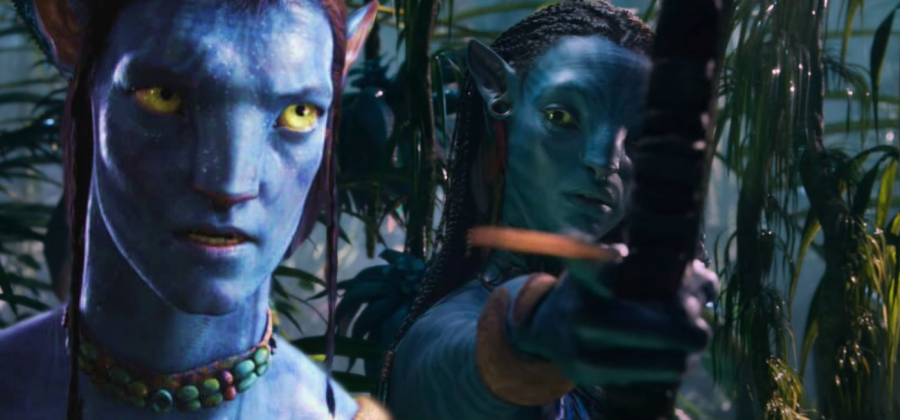A Decade Long Wait For This?
January 12, 2023
It’s been 13 years since the $237 million budgeted movie Avatar hit theaters in 2009, needless to say the film astounded audiences previously accustomed to the subpar 3d animation of the 2000’s. Life-like CGI brought a complex, alluring world for viewers to reach out to, the bewitching elements captivated audiences, so much so there was a phenomenon named Post-Avatar Depression as the fantastical planet brought more joy to many than the suburbanized Earth of which we live. Because of this, the film was incredibly vast in its viewers, as it appealed to new audiences and old film buffs, explosions, and war for the overtly masculine moviegoers, strong feminine characters and Indigenous/ African-based culture for the often underrepresented spectators, and a candid environmentalist message near the height of pollution concern for the more politically aware crowd. All this considered, it’s no surprise the picture earned $2.9 billion at the box office, to put that statement in perspective, this is hundreds of millions over the profit of Titanic, Avengers: Endgame, and is still considered the highest-grossing movie of all time as of January 2023. Overall, the movie has been awarded 9 Oscars in the year 2010 and is certified fresh on Rotten Tomatoes. Despite nearly a decade of radio silence on the sequel previously confirmed in 2010, fan’s excitement stayed consistent as they awaited the director’s remastering of the classic. Finally, December 16th the public was endowed with Avatar 2: Way of the Water.
The thing with having a vast and devoted fanbase is that there are just as devoted critics who have many qualms with the first and second motion picture. One of which has gained much traction in recent months with the release of The Way of The Water, this being the alleged appropriation and characterization of both African and Indigenous customs. This take is very divided with many Indigenous and African people taking their stance, some stating the fact their culture is being shown through blue aliens is inappropriate and for lack of a better word, alienating. Whilst others find solace and celebration in the portrayal of their traditions even if through a fictional lens as many of their values are being expressed positively. For instance, the connection between the Na’vi and their environment is incredibly strong, they live in perfect symbiosis with the creatures and when in death, return to the earth, speaking to friends and family through spiritual connections. Such appreciation is also present in the Maori tribe of New Zealand of which the Na’vi’s language is inspired by, and the Nilotic people for their appearance. Native Americans are especially important to the story of colonization, drawing back to the English invasion of America and the wrongdoings Europeans have done to both Indigenous and African people. Complication arises with the focus on Jake Sully, an American soldier some call a white savior due to his help in the battle and ignorance when learning the ways of the Na’vi. There is an argument to be made however that the very fact that Jake is learning and appreciating the Na’vi and their culture disqualifies him from the term white savior as it is defined as, “A white person who helps nonwhite people ostentatiously or for reasons viewed as self-serving, such as being admired.” He is not helping the Na’vi just because he can walk in his Avatar form but because he admires their life and wishes to keep them safe from the destructive powers of the humans of which he has important intel. However, this is at the end of the day, an opinion and there should be encouragement in forming one’s own.
On another note, while considering the amount of time it took to release the film, two factors are to blame, the demanding screenplay which pushed both CGI and the actors to their limit, and the fact that the producers filmed the second movie at the same time as the third movie, which is said to be coming out late December 2024. Despite the enormous budget of $250 million, the feature has one fatal flaw that is within the movie. A glaring inconsistency in the resurrection/ cloning of the former antagonist, Colonel Miles Quaritch. Those who watched the first movie would remember the villain for his resilience and reliance on brute force yet his death never came into question. The use of resurrection, especially after there was no foreshadowing, was thought of as cheap and lazy from a writer’s perspective. Most however could look past this as the villain made the awe-inspiring feature exhilarating. Where the film loses some spectators is the end, where the Colonel escapes death via help from his estranged son, Spider. This decision to reuse the character and add salt to the wound by making it a rescue from Spider who witnessed the terror his father brought upon people who he held dear, was simply annoying, especially considering the new, more dangerous General Adamore was swept under the rug after the Sullys left the forest. Considering the budget this is irritating to say the least, and disappointing from one of the best directors in Hollywood yet it takes very little enjoyment away from the overall viewing experience.
Nevertheless, regardless of the Colonel, there was no blatant negligence in the production. The only other inconsistencies ring insignificant in comparison, such as the amount of air in the Exopacks and the disappearance of the Metkayina Clan during the climax of the flight. The franchise is truly beloved by its creators and it is apparent when watching the movie that each character is a labor of love whether or not the audience wants them revived, there is a strong passion behind Avatar and after watching many hashed-out remakes, this film is a definitely a refresher on the importance of cinema in modern media as well as a reminder that sequels don’t have to be bad. On a personal note, I would and will be recommending this movie as it is more than worth the watch, if not for enjoyment on account of political views, for acknowledgement of its prowess.


